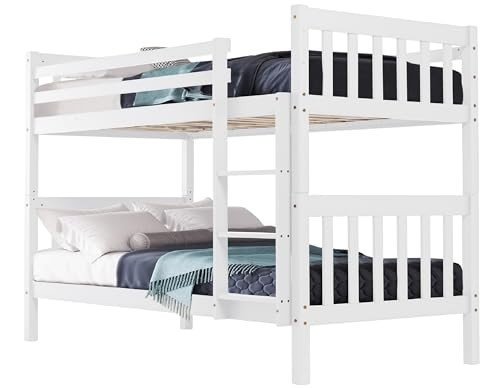The Ultimate Guide to Bunk Beds for Children: Safety, Styles, and Benefits
When it concerns styling a kid's room, parents frequently deal with the double obstacle of maximizing space while ensuring convenience and functionality. Bunk beds have actually emerged as a popular service that addresses these needs, offering not simply sleeping plans but also adding to a space's visual. In this detailed guide, we will look into different elements of children's bunk beds, concentrating on their advantages, security features, designs, and considerations for parents pondering this purchase.
Tabulation
- Advantages of Bunk Beds
- Security Features to Consider
- Types of Bunk Beds
- Style and Style Options
- Upkeep Tips
- Often Asked Questions (FAQs)
1. Advantages of Bunk Beds
Bunk beds provide various benefits for children and their parents. Here are some crucial benefits:
Space-Efficiency: Bunk beds are an excellent solution for smaller spaces. By stacking one bed on top of another, more flooring space is offered for play, storage, or research study locations.
Affordable: When kids share spaces, bunk beds can decrease the requirement for acquiring 2 separate beds, therefore saving cash.
Cultivates Social Interaction: Bunk beds can help brother or sisters or friends bond by sharing a space, creating opportunities for social advancement.
Fun Factor: The idea of sleeping "up high" includes a spirited element to bedtime, making the shift to sleeping alone easier for some children.

Versatile Design: Bunk beds can be found in different styles, colors, and designs to match any room theme, permitting personalization that shows the child's character.
2. Safety Features to Consider
Security is paramount when it concerns kids's furniture, especially when it comes to bunk beds. Here are some important safety features to assess:
| Safety Feature | Description |
|---|---|
| Strong Construction | Frames made of strong wood or metal are chosen. |
| Guardrails | Must be at least 5 inches high and extend along both sides of the upper bunk. |
| Ladder Design | Ensure ladders are safely connected and have non-slip actions. |
| Mattress Size & & Fit | Must fit snugly within the frame to prevent spaces. |
| Weight Limit | Always comply with the producer's weight limit recommendations. |
3. Types of Bunk Beds
Bunk beds come in several styles, dealing with various needs, choices, and space sizes. Here are some common types:
Standard Bunk Bed: The a lot of basic type, with one bed on top of another.
Loft Bed: Features a high upper bed with space beneath for a desk or play area.
Futon bunk beds children's (https://www.Russrenfro.top) Bed: Combines a leading bunk with a futon on the bottom, providing flexibility for seating and sleeping.
L-Shaped Bunk Bed: This style has the leading bunk set at a perpendicular angle to the bottom, developing a little corner area.
Triple Bunk Bed: Accommodates 3 children using stacked beds, suitable for big families or sleepovers.
4. Style and Style Options
When it pertains to choosing a design for children's bunk beds, the alternatives are essentially limitless. Here are some popular styles:
Traditional Style: Often made from wood, these bunk beds include ornate information and are perfect for timeless or rustic-themed spaces.
Modern Style: Characterized by clean lines and minimalist designs, modern bunk bed for adults uk beds can be made of metal or wood.
Themed Bunk Beds: Some brand names provide bunk beds formed like castles, automobiles, or playhouses, making bedtime less of a task.
Convertible bunk bed sales Beds: These can be separated into 2 specific beds, using flexibility as children grow.
Colorful Options: Bunk beds in lively colors can add a sense of delight and playfulness to any space.
5. Maintenance Tips
Keeping a bunk bed is important for longevity and safety. Here are some tips:
Regular Inspections: Check for loose screws or bolts every few months and tighten them as required.
Cleaning: Wipe down frames frequently to prevent dust accumulation; think about using a vacuum for hard-to-reach areas.
Mattress Care: Rotate bed mattress routinely and use protective covers to prolong their life.
Expect Wear and Tear: Look for any signs of damage in the wood or metal and consider replacing parts if required.
Teach Kids Safety Rules: Encourage children to use ladders properly and ensure they comprehend the security features of their bed.
6. Frequently Asked Questions (FAQs)
Q1: What age is appropriate for oversleeping a leading bunk?
A1: Typically, children aged 6 and older are suggested for upper bunk sleeping, as they have the needed motor skills to climb safely.

Q2: Do bunk beds include a bed mattress?
A2: Most bunk beds are offered as frames only, so you will need to purchase bed mattress individually. Make sure that the mattress fits the frame comfortably.
Q3: Can bunk beds be separated later on?
A3: Many styles allow conversion into 2 specific beds, offering versatility for future requirements.
Q4: How can I ensure my child's security on a bunk bed?
A4: Comply with security requirements and guarantee guardrails, a strong frame, and a secured ladder are in location.
Q5: Are there weight limits on bunk beds?
A5: Yes, constantly inspect the maker's requirements concerning weight limits to ensure safety.
Bunk beds for kids can serve several purposes while making sure safety and design. With varied designs and models offered on the marketplace, moms and dads can find a system that not just maximizes bedroom space but also shows their child's unique tastes. Similar to any furniture, understanding security functions, upkeep, and how they fit into a kid's lifestyle will make sure that these beds stay a practical furnishings option for many years to come.
Through cautious consideration and adherence to safety standards, bunk bed for adults beds can offer a lasting, fun, and practical sleeping option that kids like.


